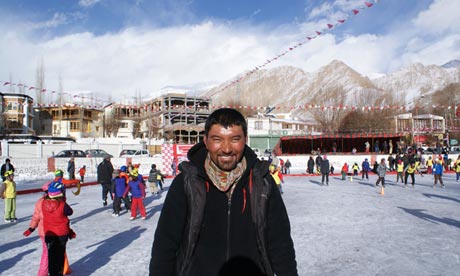
The final of the 2013 Friendship Ice Hockey Cup was a very tight affair. The London Spitfires were trailing the German-Finnish team Geronimo 1-2, with only few minutes left to play. Despite the tense final moments, some skaters seemed to have trouble focusing on the game. And who could blame them? Skating on a crisp sheet of natural ice in the middle of the Himalayas at -16C, surrounded by hundreds of curious fans, a herd of cows and the 20,000ft Stok mountain range glowing in the afternoon sun ... it is hard to think of a hockey location more remote or stunning. Welcome to the Himalayan Hockey Adventure of Leh, Ladakh, Kashmir.
Looming above the ice rink was the 1,000-year-old Buddhist monastery of Spituk, its long lines of prayer flags just visible from the wooden player benches, and the imposing medieval city palace, built in the 1600s. During breaks between play dozens of kids mingled excitedly with the foreign guests, scarcely supervised by their elders, who chatted over cups of sugary cinnamon tea while watching the action from the stands.
The two finalists had made their way up to India's northernmost district to become the first international teams to participate in the annual tournament hosted by the Ladakh Winter Sports Club (LWSC) – and they were enjoying every minute of it. "The atmosphere is just incredible. I have played hockey literally all across the globe, but I've never experienced anything like this", said Geronimo captain Markus Nirschl.
It is not only the gorgeous views and bizarre surroundings that amaze the European hockey players. India is hardly known as a hockey nation, and the infectious local enthusiasm for the sport comes as a bit of a surprise. "From the first snow in December until springtime in March, Ladakh lives and breathes ice hockey", said LWSC president N A Gyapo.
He was not exaggerating. Day in, day out Leh's central rink is buzzing with energy. Skaters of all ages and backgrounds occupy the ice non-stop. Important local matches are watched by crowds of up to 3,000, some people hanging in the nearby trees to secure the best view. Even the Indian army, heavily present in Leh with 60,000 troops, supports the sport and gives its soldiers time off to hone their hockey skills. Since 2008, India even fields a national team, which celebrated its first victory last year with a 5-1 win over Macau.
Ladakh's passion for hockey is especially impressive considering the sport's humble beginnings here. Legend has it that in the early 1970s a troop of scouts tied self-made blades under their army boots, cut a puck out of old rubber soles and used plastic bottles nailed to pieces of wood as rudimentary sticks. It was only after 1985, when the LWSC was founded, that things got a little more organised. Part of the sport's rapid recent development is down to the support LWSC has received from the Canadian high commission in New Delhi since 2001, when the commission's very own New Delhi Sacred Bulls first participated in the tournament.
But the bottom line on why ice hockey is growing so quickly in Ladakh is simple: outside the summer season there is little else to do. "In winter, hockey is one of the very few reasons to get out of bed in the morning", said Tundup Namgail, who coaches one of the local junior teams. The schools are closed, as are most big roads. Leh's population dwindles to 30,000, less than half the amount of people that cater to the constant stream of tourists during the warmer months, when people can enjoy a wealth of outdoor activities – from hiking and rock-climbing to wild-water rafting – as well as incredible cultural sites that have earned the region the nickname of "Little Tibet". Even the Dalai Lhama has a summer residence just a short drive from Leh.
The hope is that ultimately winter tourism will flourish on the back of more international tournaments like this year's Friendship Cup. The impact European participation had on this year's event has certainly been felt. The locally-owned Grand Dragon Hotel (+91 1982 250 786, thegranddragonladakh.com) was nearly full during the tournament – something otherwise unheard of during the low season – and a new hotel is being built next to Leh's central ice rink, ready to receive hockey fans and alpinists by next season.
However, progress in other areas is slow. A prominent part of the plan to attract more hockey tournaments – the construction of an Olympic-sized ice stadium in the outskirts of Leh – has been put on hold due to lack of funding, leaving the massive concrete shell of the building peeking gloomily out of the thick snow cover.
Until its completion locals and tourists will have no choice but to enjoy the magnificent panorama offered by Leh's outdoor rink. Back there on the ice, seconds before the end of the final, London Spitfires finally scored the equaliser. And with the sun threatening to disappear and leave the rink in darkness, the 2013 Friendship Cup final was pronounced an amicable tie.
• For more information on how to join as a team or the best times to watch, the LWSC can be contacted on ladakhwintersportsclub@gmail.com.

